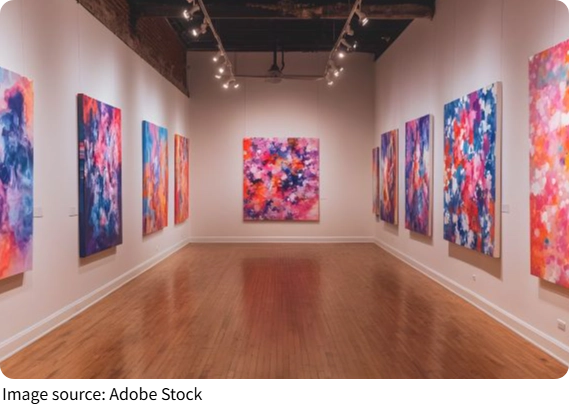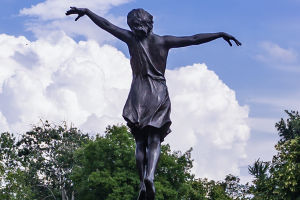Impressionism

Imagine standing in front of Monet's Water Lilies. At first glance, it seems like a blur of color. But take a closer look, and you'll see an entirely new way of seeing the world—through mood, motion, and light.
This wasn't just a style; it was a revolution. Impressionism didn't just change how art looked—it changed what art meant. And its influence rippled far into the 20th century, shaping every major modern movement that followed.
So, how did a group of artists once dismissed as rebels become the foundation for modern creativity? Let's explore the powerful legacy of Impressionism.
Breaking the Frame: The End of Strict Realism
Before Impressionism, art was dominated by strict academic rules. Artists aimed for detailed realism, often with historical or mythological subjects. But Impressionists like Claude Monet, Edgar Degas, and Pierre-Auguste Renoir broke those rules. They stepped outside, painted natural light, used visible brushstrokes, and captured fleeting moments—things traditional critics once rejected.
This shift away from realism opened the door for the modern art of the 20th century. Expressionism, Fauvism, and even Abstract art owe their origins to Impressionism's bold challenge to the status quo. By proving that art didn't need to imitate life perfectly, the Impressionists made space for artists to explore inner worlds, abstract emotions, and new techniques.
The Rise of Color and Emotion
One of the most lasting contributions of Impressionism was its fearless use of color. Instead of blending, artists placed bright hues side by side to simulate light and motion. This inspired 20th-century movements to treat color as a language of emotion, not just description.
For example, Henri Matisse of the Fauvist movement pushed color beyond realism to evoke energy and feeling. The Expressionists took this even further, using exaggerated tones to mirror psychological states. Without the Impressionists' experiments in color, this emotional range in modern art might not exist.
New Techniques, New Freedom
Impressionism introduced not just new ideas, but new methods. Quick brushstrokes, textured surfaces, and open compositions allowed artists to work faster and more spontaneously. This approach was liberating—and contagious.
Cubist artists like Picasso later deconstructed form entirely, but their roots lay in the same idea: that the canvas was not a window into reality, but a playground for interpretation. Abstract artists such as Kandinsky and Piet Mondrian also embraced the freedom to focus on movement, rhythm, and feeling over literal representation. This evolution of style can be directly traced to Impressionism's revolutionary techniques.
Changing the Viewer's Role
Another subtle but powerful legacy of Impressionism lies in how we see art. Impressionist paintings invite interpretation. Since the details are loose and suggestive, each viewer may see something slightly different. This participatory experience changed the relationship between art and audience.
In the 20th century, this idea became central. Surrealism, Dadaism, and Conceptual Art all played with perception, ambiguity, and viewer interaction. Impressionism planted the seed by letting the viewer become part of the artwork's meaning.
The Lasting Legacy
Though more than a century has passed, the echo of Impressionism still rings through galleries today. Its influence is visible not only in painting but also in photography, film, and digital art. By prioritizing experience over perfection, Impressionism laid the groundwork for the creativity and experimentation that define contemporary art.
Even artists who moved far beyond its aesthetic—such as Jackson or Mark Rothko—were building on the freedom that Impressionism made possible.

Conclusion: From Brushstrokes to Boldness
Impressionism was never just about painting flowers or sunsets. It was about reimagining how we see, feel, and express. By stepping outside of tradition and capturing the world in motion and light, Impressionist artists created a movement that still pulses through modern art today.
So next time you pass an abstract piece, a vivid color splash, or even a digital animation, remember: the roots may stretch back to a group of artists who chose to see the world differently—and had the courage to paint it that way.
What do you think is the most influential art movement of all time? Drop your thoughts and let's discuss!
-
 ImpressionismFrom Fleeting Light to Bold Vision: How a 19th-Century Movement Transformed 20th-Century Creativity
ImpressionismFrom Fleeting Light to Bold Vision: How a 19th-Century Movement Transformed 20th-Century Creativity -
 Abstract ArtBeyond Shape and Color: How Abstract Artists Use Form to Channel Deep Human Emotion
Abstract ArtBeyond Shape and Color: How Abstract Artists Use Form to Channel Deep Human Emotion -
 Sculpture Shapes CitiesHow Sculpture Transforms Urban Aesthetics and Enhances City Landscapes
Sculpture Shapes CitiesHow Sculpture Transforms Urban Aesthetics and Enhances City Landscapes